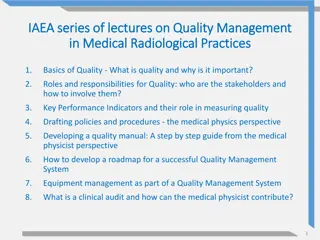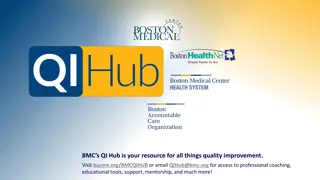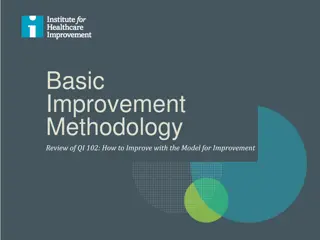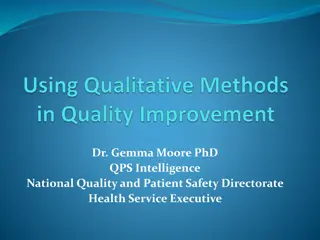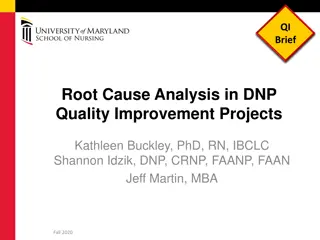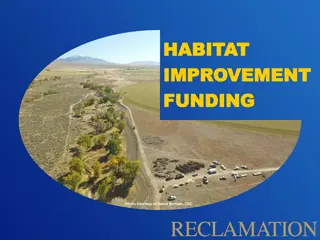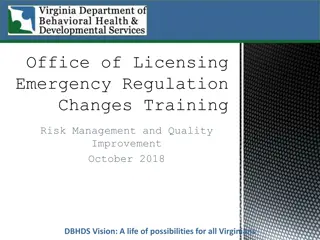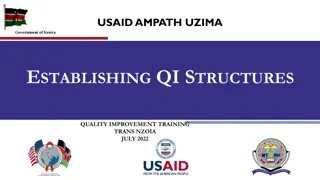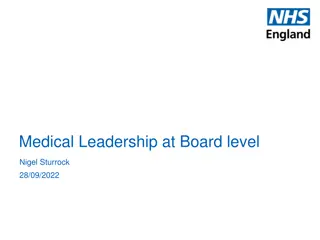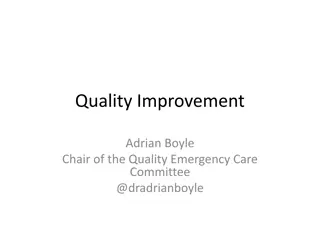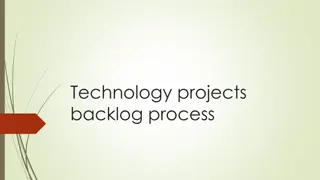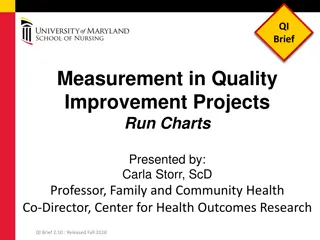Importance of Quality Improvement Projects in Medical Training
Trainees in medical fields are urged to engage in Quality Improvement Projects (QIPs) to enhance patient care, safety, and clinical effectiveness. These projects involve identifying areas for improvement, implementing changes, and measuring the impact of interventions. QIPs are emphasized in medical training to foster continuous learning, build leadership skills, and ensure high-quality patient care throughout a doctor's career.
Download Presentation

Please find below an Image/Link to download the presentation.
The content on the website is provided AS IS for your information and personal use only. It may not be sold, licensed, or shared on other websites without obtaining consent from the author. Download presentation by click this link. If you encounter any issues during the download, it is possible that the publisher has removed the file from their server.
E N D
Presentation Transcript
Quality Improvement Project QIP Dr Chris Webb - December 2020
The trainee is in good position to identify areas of practice that frustrate them and that possibly have an impact on patient safety. During their primary care posts in ST1 /2 they are required to complete a quality improvement project with the aim of improving patient care. Audit is a type of QIP as both look at the quality of care provided with the aim of improving it and both require measurements to demonstrate change. More generally, QIPs can be about making small incremental changes and measurements which may be done weekly to test the impact of the changes. In contrast an audit has set criteria, each with their own defined standards, and has two sets of measurements over a longer time period, to demonstrate a baseline and then improvement. Completing a QIP allows change to be tested both quickly and successfully and is easier to do in a short time frame, for example in a 4-6 month trainee post. The QIP should be written up in the relevant section on the Portfolio and the supervisor will both assess and discuss this with them
RCGP Curriculum 2018 Maintaining Performance Learning and teaching Critically reviewing experience in practice should become a habit that is maintained over the whole of your professional career. Knowing and applying the principles of lifelong learning and quality improvement should be considered an essential competence for every GP Participate in personal and team performance monitoring activities and use these tools to evaluate practice and suggest improvements
GMC Generic Capabilities 2016 All trainees should design and implement quality improvement projects that improve clinical effectiveness, patient safety and patient experience by: Using data to identify areas for improvement Examining information from audit, inquiries, critical incidents or complaints, and implementing appropriate changes Employing quality improvement methods, such as plan, do, study, act cycles Undertaking the importance of patient and public involvement in decision making at group level and when changes to services are proposed Engaging with stakeholders, including patients, doctors and managers, to plan and implement change Effectively measuring and evaluating the impact of quality improvement interventions)
Why QIP? Trainees should Take part in regular and systematic clinical audit and/or quality improvement - Gold Guide 2017 A progressive curriculum in quality improvement activity should underpin all training stages of a doctor, building capability and leadership, and a foundation for on-going lifelong learning and implementation - Academy of Royal Colleges, March 2016
Undertaking a QIP It needs to be decide what the aim of the project is going to be Projects can be chosen following a significant event, a patient complaint; or an area of care they feel passionate about Do not make the project too complicated; it needs to be completed within a primary care placement in ST1/2 The project should aim to improve patient safety or care and be SMART
SMART Specific - do not make it too broad and chose something of interest. Words such as increase / reduce help to set a clear goal Measurable - ensure that there is something they can easily measure to demonstrate any change. It can be qualitative data (descriptive) as well as quantitative data (numerical data) Achievable - ensure the data is easily collectable and keep the aims simple Relevant - project should be focused on patient safety Time defined - choose something that can be done in the time frame. They need to be able to complete their project in their primary care placement
Audit Identify a problem Define standards Collect data Analyse Implement change Re-audit
Model for Improvement Asks three questions: Aim - What are we trying to accomplish? Measure - How will we know if a change is an improvement? Change - What changes can we make that will result in improvement? PSDA cycle Plan - Objective questions and predictions (why). Plan to carry out the cycle (who, what, where, when) Act - What changes are to be made? Next cycle? Study - Complete the analysis of the data. Compare data to predictions. Summarise what was learned Do - Carry out the plan. Document problems and unexpected observations. Begin analysis of the data
Repeated PDSA cycles work towards the AIM What am I trying to achieve? How will I know a change is an improvement? What changes can I make that will result in the improvement
WBPA QIP Expect to do in ST1-ST2, ideally during GP placement Marked against agreed standards in a similar way to COTS and mini-CEX s No pass or fail but will contribute to evidence in the related competencies: (Fitness to practice; maintaining performance learning and teaching; data gathering and interpretation ; working with colleagues and in teams; organisation management and leadership) Trainees write up project and share with ES. No further changes made. ES provides feedback (may be aware of impact in practice)
Unsatisfactory project No team engagement No engagement of stakeholders (people affected by change including patients) No or minimal measurement No real attempt at implementing change, just a discussion that change should happen
QIP Template & Feedback Level Descriptors
The GP Trainee Assessment Framework 1. Project Title and why it was chosen 2. Project Aim 3. Describe what baseline data or information you gathered 4. Describe what subsequent data or information you gathered 5. How did you plan and test out your changes? 6. How have you engaged the team, patients and other stakeholders throughout the project? 7. Summarise the changes as a result of your work and how these will be maintained 8. What have you learnt and have you got any outstanding learning needs? 9. Overall competence at which the trainee has shown that they are performing is assessed at the end
1. Project Title and why it was chosen You should explain what trigger (case, data or events) led you to look at this area You should comment on the likely impact of this on patients, and review the guidance or evidence that is relevant to the area (e.g. a literature review)
Project Title and why it was chosen Below expectations Title is unclear or confusing, or has no significant justification based on links to personal or practice needs There is no reflection on the known guidance or evidence relating to this area. There is no consideration of the impact on patients Meets expectations Clear title which is understandable, and has a link to personal or practice needs There is reference to some appropriate guidance and/or to evidence There is consideration of the impact of the QIA on patients Above expectations The title and reasons are clear and are based on an identified practice need or clear personal experience The guidance and evidence that is identified is appropriate, clear and well chosen (not excessive) The assessment of impact on patients includes reference to prevalence/ incidence and severity etc Assessment of impact considers how teamwork has been made more effective
2. Project aim When explaining your project aim, consider what you are trying to accomplish, how will you know that a change is an improvement and what change you could make that would result in an improvement in patient safety or patient care?
Project aim Below expectations The aim is vague with no specific goal or time frame. There is no clear consideration of what is being accomplished or that a suggested change is an improvement. It is not clear how the project will improve patient safety or patient care Meets expectations The goal set is specific with a clear time frame There is consideration of what is being accomplished or that a suggested change is an improvement There is some suggestion that there is a connection with patient safety and/or patient care Above expectations The aim is summarised in a SMART (Specific, Measurable, Achievable, Relevant and Time defined) format There is clear consideration of what is being accomplished and that a suggested change is an improvement It is clear how the project will improve patient safety or patient care
3. Describe what baseline data or information you gathered You should explain how you understood the current position in order to decide that improvements were needed. Explain which QI tools or methods you used to fully understand the problem you were trying to solve. Suitable methods would include QI tools for example; assessing baseline data, process-mapping, conducting a survey and using fishbone analysis. Quality improvement requires attempting to measure some change, though the nature of the measurement will be different in different projects and some data could be available before the start of your personal involvement.
Describe what baseline data or information you gathered Below expectations Insufficient information is provided to demonstrate the problem was fully understood prior to the improvement being designed and implemented It is unclear which QIA process/processes or tools have been used or those used have not been followed through appropriately Meets expectations There is enough evidence obtained to demonstrate the problem was fully understood prior to implementing improvements There is a clear and appropriate use of a recognised QIA process/ processes or tools Above expectations The evidence which is obtained is well chosen and may be of different types using a range of QI tools. There is justification of the amount of evidence obtained (i.e. explanation of why there is not more or less evidence) There is clear presentation of the evidence The selection and use of tools for improvement has been well justified for the project
4. Describe what subsequent data or information you gathered How did you measure and evaluate the impact of change? Please share enough data to demonstrate outcomes; you may not need to share all your data
Describe what subsequent data or information you gathered Below expectations The data shared is not capable of demonstrating the changes suggested e.g. because of the way it has been collected, or because the data is not appropriate Meets expectations The data provided is clear and the evaluation of the data is appropriate and considers other possible causes for the changes observed. Data collection is relevant and is collected over time though could have been more comprehensive. Above expectations The data is well presented; clearly evaluated and well chosen There is evidence of multiple data collection at appropriate intervals in time There is an understanding of the potential limitations of different methods of data collection
5. How did you plan and test out your changes? Effective QI work involves testing out changes (small cycles of change) and then learning from this experience and building on it How did you apply this principle to your QI project?
How did you plan and test out your changes? Below expectations There is no evidence of small cycles of change or use of model for improvement or PDSA (Plan, Do Study Act) Meets expectations There is a clear and appropriate use of a PDSA cycles in the planning and implementation of the project Above expectations The project shows clear evidence of a PDSA approach There is evidence of multiple and sequential tests of change
6. How have you engaged the team, patients and other stakeholders throughout the project? Describe any challenges of getting different team members engaged with your QIA Describe how you maintained momentum e.g. planning for an early win:win
How have you engaged the team, patients and other stakeholders throughout the project? Below expectations There is no team input or the description of this is unclear There is inadequate reflection on steps taken to engage stakeholders There is inadequate reflection on the challenges of engaging different team members with no reflection on personal learning from this Meets expectations There is a description of how different stakeholders were engaged which includes patient involvement There is description of the challenges of engaging particular stakeholders which remains focused on this event Above expectations The description of how stakeholders (including patients) were engaged demonstrates insight into the need for adaptability and generating win : win positions There is reflection on the particular difficulties of engaging some individuals or patient groups and thoughts on personal learning from this for the future The different roles of team members in the team are considered and used productively
7. Summarise the changes as a result of your work and how these will be maintained If improvement was not achieved, explain why and what you learnt about this Describe how you relayed your results to the team and the feedback you received
Summarise the changes as a result of your work and how these will be maintained Below expectations The summary provided is not clear or specific, or the conclusions offered are n9t consistent with the earlier work. There is a reliance of people following new protocols and human behavioural change in order for the changes to be sustained. There is no clarity about the sustainability of the changes Meets expectations The summary of the changes is clear and appropriate. There is a clear consideration of steps to enable maintenance of changes. There is evidence of an understanding of the role in changing systems to embed improvement. Change has been embedded by the organisation Above expectations The summary of changes is clear and broken down to demonstrate how each part can be maintained. There is evidence that systems have been changed so that it is harder to revert to old processes and easier to continue to follow the new processes. This will ensure that change is embedded and sustainable ie not just a protocol
8. What have you learnt and have you got any outstanding learning needs? Think about what you will maintain, improve and stop in QIA? It is important to consider what changes you might need to make as you continue to engage with QIA, for example consider the size of project, the amount of evidence collected, how you worked with others, the effective use of IT, its value to long term care and its impact on sustainability (health outcomes for patients and populations from an environmental, social and financial perspective)
What have you learnt and have you got any outstanding learning needs? Below expectations There is little reflection on the personal learning from the QIP which has been completed and how to use this is future QIP, leadership, or other situations Meets expectations The reflection on QIP demonstrates appropriate personal learning about leading change and choosing effective tools to enable improvements to patient care / safety / experience. Consideration has been given to the value and sustainability of the QIP Above expectations The reflection on this QIP goes beyond the meets expectations descriptors and is clearly linked to plans for future QIP in a realistic and clear way. The QIP highlighted the impact of sustainability on health outcomes from several different perspectives



